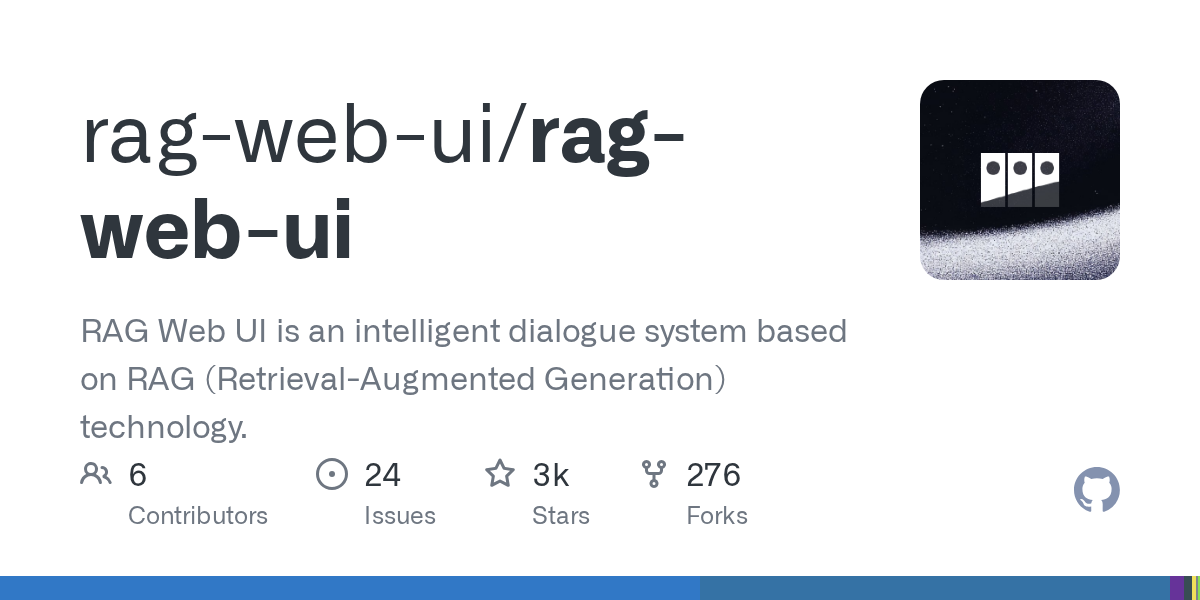RAG Web UI: An Intelligent Dialogue System with Retrieval-Augmented Generation

Summary
RAG Web UI is an intelligent dialogue system leveraging Retrieval-Augmented Generation (RAG) technology to build robust Q&A systems. It enables users to create knowledge bases from various document formats and supports multiple LLM deployment options, including cloud services and local models like Ollama. The system also offers OpenAPI interfaces for seamless integration.
Repository Info
Tags
Click on any tag to explore related repositories
Introduction
RAG Web UI is an intelligent dialogue system based on Retrieval-Augmented Generation (RAG) technology, designed to help users build intelligent Q&A systems using their own knowledge bases. It combines document retrieval with large language models to provide accurate and reliable knowledge-based question answering services.
The system offers flexible LLM deployment, supporting cloud services like OpenAI and DeepSeek, as well as local models via Ollama, catering to diverse privacy and cost requirements. It also exposes OpenAPI interfaces for convenient programmatic access to knowledge bases.
Key features include intelligent document management, an advanced dialogue engine, and a robust architecture built with a frontend-backend separation, distributed file storage, and high-performance vector databases like ChromaDB and Qdrant.
Installation
To get started with RAG Web UI, follow these steps:
Prerequisites
- Docker & Docker Compose v2.0+
- Node.js 18+
- Python 3.9+
- 8GB+ RAM
Steps
- Clone the repository:
git clone https://github.com/rag-web-ui/rag-web-ui.git cd rag-web-ui - Configure environment variables:
cp .env.example .env - Start services (development server):
docker compose up -d --build
Verification
After service startup, you can access the following URLs:
- ? Frontend UI: http://127.0.0.1.nip.io
- ? API Documentation: http://127.0.0.1.nip.io/redoc (for local deployment)
- ? MinIO Console: http://127.0.0.1.nip.io:9001
Examples
RAG Web UI provides a comprehensive platform for managing knowledge bases and interacting with an intelligent chat interface. Users can upload documents in various formats, such as PDF, DOCX, Markdown, and Text, which are then automatically chunked and vectorized for efficient retrieval.
The chat interface supports multi-turn contextual dialogue and provides reference citations, ensuring transparency and accuracy in responses. For developers, the system offers OpenAPI interfaces, allowing for seamless integration and programmatic access to the knowledge base functionalities.
Visual examples of the Knowledge Base Management Dashboard, Document Processing Dashboard, and the Intelligent Chat Interface with References are available in the project's GitHub repository.
Why Use RAG Web UI?
Consider RAG Web UI for your projects due to its powerful features and flexible architecture:
- Flexible LLM Integration: Supports a variety of LLM providers, including OpenAI, DeepSeek, and local Ollama models, offering adaptability for different use cases and environments.
- Comprehensive Document Management: Handles multiple document formats, featuring automatic chunking, vectorization, asynchronous processing, and incremental updates.
- Advanced RAG Capabilities: Delivers precise retrieval and generation, supporting multi-turn contextual dialogue and providing verifiable reference citations.
- Robust and Scalable Architecture: Designed with frontend-backend separation, distributed file storage (MinIO), and pluggable vector databases (ChromaDB, Qdrant) for high performance and scalability.
- Developer-Friendly API: Offers OpenAPI interfaces for easy integration into existing applications and workflows.
Links
- GitHub Repository: https://github.com/rag-web-ui/rag-web-ui
- License: Apache-2.0
- DeepWiki: https://deepwiki.com/rag-web-ui/rag-web-ui
- Local API Documentation: http://127.0.0.1.nip.io/redoc